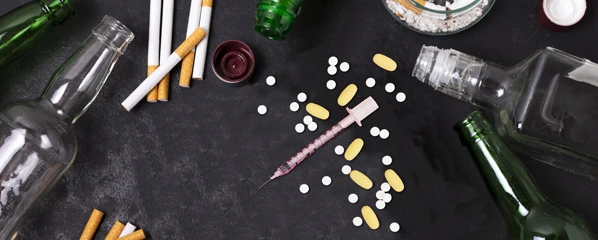Author's details
- Hakim A Abubakre
- BA (Hons) International Business Management, Msc Digital Marketing.
Reviewer's details
- Dr. Khashau Eleburuike
- MBBS (Ilorin) MSc. Global Health Karolinska Institute.
- Resident doctor in family medicine in Northen Sweden.

- Date Published: 2025-03-19
- Date Updated: 2025-03-19
Drug and Alcohol Disorders
Drug and alcohol disorders happen when someone uses substances like alcohol or drugs in a harmful way. These substances change how the brain works, causing problems for the person and people around them. Common substances include:
- Alcohol
- Caffeine containing products like kola nut and coffee.
- Khat
- Cannabis (weed)
- Opioids (e.g., painkillers)
- Tobacco (cigarettes)
- Stimulants (e.g., amphetamines)
These substances make people feel good temporarily but can cause harm in the long run, affecting their health, work, and relationships.
Several factors can lead to drug or alcohol problems, such as:
- Family history: If others in your family have problems with drugs or alcohol, you may be at higher risk.
- Environment: Being around others who use drugs or alcohol can influence you.
- Personality: Some people may be more likely to use substances because they seek excitement or have difficulty managing stress.
- Mental health: Conditions like depression or anxiety often come with substance use.
- Social pressures: In some cultures, drug or alcohol use may seem normal or acceptable. This may be rampant among adolescents males who may be involved in fighting and bullying.
Here are common signs that someone might have a drug or alcohol problem:
- Using more of a substance than intended
- Failing to stop or reduce usage, even when trying to
- Spending too much time getting or using the substance
- Ignoring responsibilities at home, work, or school due to substance use
- Losing interest in activities they used to enjoy
- Taking dangerous risks, like driving while drunk or high
- Needing more of the substance to get the same feeling (tolerance)
- Feeling sick or having withdrawal symptoms when not using the substance.
If someone has used drugs or alcohol and shows any of these signs, get medical help right away:
- Trouble breathing
- Seizures (convulsions)
- Passing out or losing consciousness
- Chest pain (may signal a heart attack)
- Any serious physical or emotional reactions.
There are several ways to treat substance use disorders. These treatments depend on the person's health, the type of substance being used, and the severity of the problem:
- Detoxification: This is when the body gets rid of the substance, sometimes with the help of medicine to reduce withdrawal symptoms.
- Therapy: Talking to a therapist can help people understand why they use substances and find ways to stop.
- Support groups: Groups like Alcoholics Anonymous (AA) or similar community groups provide support from people who have gone through the same struggles.
- Medication: For some addictions, doctors can prescribe medication to help with cravings and withdrawal symptoms.
- Ongoing support: Long-term recovery involves continued support from health workers, family, and the community.
Here are ways to prevent substance use problems:
- Learn about risks: Understand how substance use can turn into an addiction.
- Avoid peer pressure: Spend time with people who don’t use drugs or alcohol, and learn to say "no" to those who encourage it.
- Take care of mental health: Get help for conditions like depression or anxiety.
- Know your risks: If you have a family history of addiction or have a non-assertive personality, be extra careful.
- Stay balanced: Manage stress by doing healthy activities like exercise, healthy hobbies, or spending time with family and friends.
Drug and alcohol use can cause serious problems, but with early help, the effects can be reduced. Treatment, support, and understanding the risks are important to managing and preventing substance abuse. Recognizing the signs early and seeking help can improve the quality of life for those struggling with addiction.
- Ogundipe O, Amoo EO, Adeloye D, Olawole-Isaac A. Substance use among adolescents in sub-Saharan Africa: A systematic review and meta-analysis. South African Journal of Child Health. 2018 Sep 17;2018(1):s79-84.
- Ebrahim J, Adams J, Demant D. Substance use among young people in sub-Saharan Africa: a systematic review and meta-analysis. Frontiers in psychiatry. 2024 Sep 11;15:1328318.
- Kugbey, N. Prevalence and correlates of substance use among school-going adolescents (11-18years) in eight Sub-Saharan Africa countries. Subst Abuse Treat Prev Policy 18, 44 (2023). https://doi.org/10.1186/s13011-023-00542-1
- Alozai UU, Sharma S. Drug and Alcohol Use (Archived). 2023 Jul 21. In: StatPearls [Internet]. Treasure Island (FL): StatPearls Publishing; 2025 Jan–. PMID: 30020635. https://pubmed.ncbi.nlm.nih.gov/30020635/
- https://www.hopkinsmedicine.org/health/conditions-and-diseases/substance-abuse-chemical-dependency
- https://www.mayoclinic.org/diseases-conditions/drug-addiction/symptoms-causes/syc-20365112
- https://my.clevelandclinic.org/health/diseases/16652-drug-addiction-substance-use-disorder-sud
